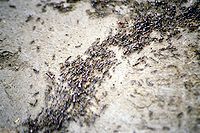
Photo from wikipedia
Abstract This paper proposed a topology optimization method for modifying the No-moving-part (NMP) microvalves to enhancing performance and reducing drive power. No-moving-part microvalves are check microvalves without movable devices, which… Click to show full abstract
Abstract This paper proposed a topology optimization method for modifying the No-moving-part (NMP) microvalves to enhancing performance and reducing drive power. No-moving-part microvalves are check microvalves without movable devices, which allow fluid to pass freely in one direction while hindering flow in the reverse direction. They only depend on the inertial force of flow rather than the mechanical mechanism. Taking into account that the fluid being transferred in the microsystem is often a biological or chemical medium, the non-Newtonian fluid (such as blood) is selected necessarily for optimization. At the same time, several previous studies have widely used diodicity to indicate the performance of NMP microvalves. However, higher diodicity does not reflect the degree of forwarding energy dissipation, leading to a significant pumping power to drive flow. Therefore, the pressure drop of forwarding flow and the performance of the NMP microvalve are handled independently by a bi-objective formulation, during the design of the NMP microvalve. In the numerical implementation, Helmholtz-type Partial Differential Equation (PDE) based filter and smoothed Heaviside projection filter are utilized to produce discrete solutions, thus solving ill-posedness. This paper presents a density-based bi-objective topology optimization (TO) method of Tesla microvalves, in which the modified artificial Darcy friction force term is added to the Navier-Stokes equations. Finally, several numerical examples of the bi-objective functions are studied and the validity of the topology optimization method presented in this paper is demonstrated.
Journal Title: Chemical Engineering Journal
Year Published: 2020
Link to full text (if available)
Share on Social Media: Sign Up to like & get
recommendations!